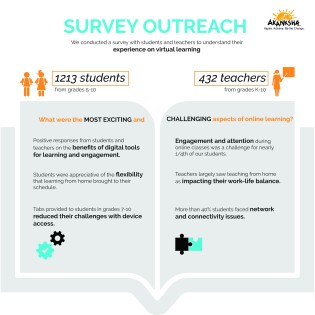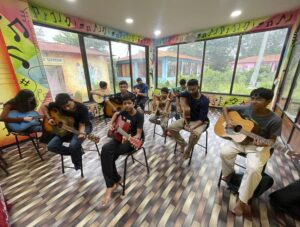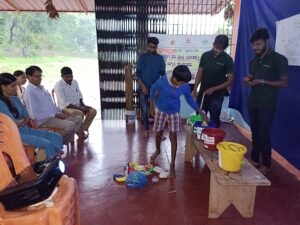Since school closures due to the COVID-19 pandemic, online learning has become the ‘new normal’. As essential as closing schools was, learning in the virtual space requires a lot of adjustment and acclimatization from teachers, students and parents. At Akanksha we put in place different strategies to make this transition less daunting. This article highlights the key insights from our teachers and students on their experience with virtual learning for an entire academic year.
India’s newly appointed Union Education Minister, Shri Dharmendra Pradhan, recently stated, emphasizing on the importance of technology in education, “technology will help in achieving the goals of open, inclusive and accessible education”.
With the complete closure of schools since the COVID-19 pandemic in March 2020, leveraging technology to ensure that students have access to quality education has been the need of the hour. According to the SDG India Index 2020, the national score for SDG 4 (quality education) has gone up by 6 points since 2019. The integration of technology is said to be a ‘democratizer in education’. It is enabling all students to access the same resources and tools. Along with introducing theories and concepts in a more engaging way, it is allowing children to learn at their own pace and time. Online learning is enhancing digital literacy and preparing students for a future where technology and the internet will be the primary way of life.
In spite of this progress, virtual learning has brought with it a host of challenges – a digital divide with respect to device and internet access across different socio-economic backgrounds, low digital literacy among both children and teachers, an unconducive learning environment at home, impact on both physical and mental health due to constantly glaring at a screen and a lack of social connectedness.
VIRTUAL LEARNING AT AKANKSHA
With the onset of the lockdown, Akanksha schools also went into an online mode of teaching and learning. All of our schools were equipped with computer labs that were regularly used by students. Additionally, eight of our 21 schools also had access to either iPads provided by Apple or tablets provided by Motivation for Excellence (MFE) under the Nalanda Project.
Technology and access to digital tools is not new to Akanksha. The fact that children had been exposed to some technology access within the school prior to the pandemic helped integrate technology seamlessly for a fair proportion of our students. Akanksha was able to plan a well structured experience for our teachers, students and parents. The infographic below reflects our foray into virtual learning in the last academic year as well as our plan for the current academic year.

STUDENT & TEACHER INSIGHTS ON VIRTUAL LEARNING
At Akanksha, we regularly hear from our teachers and students through surveys to understand their experience at school. It helps us identify areas of celebration and improvement, which feeds into our planning for the upcoming year.

Teachers and students were asked to share the most exciting and challenging aspects of online learning. Below are the key trends that emerged.
Engagement and focus during online learning
The engagement and focus from students during online learning rests on two key factors – the extent to which innovative and engaging learning tools are used in class; availability of a non-chaotic learning environment at home.

1/4th of our teachers said that keeping students engaged and attentive during an online lesson is a challenge and using engaging and innovative learning tools eases this process.
“One of the most challenging parts of teaching virtually is to focus equally on all students and bridge the gaps in learning pace.”-Teacher, Akanksha School in Pune
“Teaching online has been a great opportunity for me to be more creative and innovative through different teaching applications and tools.”-Teacher, Akanksha School in Pune
24% students said they find it difficult to give their undivided attention to online classes, while 22% students also said that online classes have improved their participation in class and motivation to learn.
This difference in perception on student engagement is largely because it is in higher classes (grades 8 & above) where the difficulties with focus and attention are concentrated. Students in the higher grades also reported being worried about household chores, economic distress brought on with the lockdown etc. These factors go on to impact their holistic engagement in classes.
Using technology to teach and learn
There was a unanimous agreement across the teacher and student survey about the positive impact of tech tools in teaching and learning. Teachers said that using app-based puzzles and quizzes made online classes exciting and fun. Students were also able to grasp difficult concepts and theories better through videos and presentations.
“Our school has organised online classes for us so we do not miss out on learning in the midst of school closures. I think it is a great way to study using videos, pictures etc and has helped us students during this lockdown.”-Student, Grade 10, Akanksha School in Mumbai
“Technology has been a great leveller; in that it has enabled us to stay connected and continue education for students even during the pandemic. Using different methods to teach my students during online classes and seeing the excitement of students to get back to learning has been my driving force.”-Teacher Leader, Akanksha School in Pune
Access to devices and connectivity
In spite of technology being a leveller and engaging tool for virtual learning, the access to technology (devices and internet connectivity) is not universal. Especially in the communities Akanksha works with, the availability and affordability of these resources poses a challenge.
The survey results showed that internet connectivity issues were mentioned by both students and teachers as a challenging aspect of online learning. This concern was more widely expressed by students. 41% students said that poor data/network results in them having to miss/drop out of classes. In comparison only 15% of teachers faced this concern.
“Inability to attend class due to lack of devices at home and network issues during synchronous classes results in a general lack of motivation among students to learn and engage in class.”-Teacher, Akanksha School in Mumbai.

Access to a device to attend classes was a challenge only for students. With Akanksha’s support to higher grade students in this regard, challenges with access to devices declines grades 7 and above.
Flexibility in teaching and learning
Students (21%) were more appreciative of the flexibility that learning from home brought to their schedule.
“I really like how in the new school system I can study at any time using recording and videos.”-Student, Grade 9, Akanksha School in Mumbai
Only 3% teachers were positive about this trend and 8% spoke of virtual teaching impacting their work-life balance.
“Because we teach from home, drawing clear lines between school and family has been difficult.”-Teacher, Akanksha School in Pune
HOW ARE WE USING THE SURVEY RESULTS?
The survey with teachers and students was a starting point for us as a network to reflect on what has worked and what needs change in strategy to plan online instruction in the most efficacious manner.
Strengthening and scaling up best practices: Some of our practices (like having digital leaders for each school as a point of contact for all central digital trainings) worked very well and have been appreciated by all stakeholders. We plan to strengthen such practices and scale it up for the entire network.
Building knowledge exchange platforms: The reflections post the survey with teachers and school leaders showed that while each school has a similar mode of operation, each had their own unique way of building virtual learning and addressing the challenges associated with it. For instance, some schools plan to have two facilitators on online classes to improve student engagement, while other schools have created two homogenous groups for each class to ensure that all students participate. Akanksha has been organising sessions where school stakeholders share experiences with best practices, challenges, and strategies to address them.
Integrating teacher experiences to improvise online teaching: Based on the survey results, schools conducted reflection exercises with teachers to understand the nature of challenges they face while teaching online. The reflections and inputs from teachers have served useful in improvising online teaching methods and has boosted overall professional development of the school.
Emphasis on parent engagement as a key to student engagement: Our survey results have reflected that student engagement in online classes has been unstable, especially in higher grades. To address this we will be building on our relation with parents to –
-set expectations with them on the commitment needed from them and students during online learning
-support parents with scheduling the child’s daily routine, nutrition plan and building a conducive home environment
-problem-solve along with parents in case of other academic or development related challenges
Building a robust model for blended learning: At Akanksha, even before the pandemic, we envisioned a ‘blended learning’ process for our students – a balance between traditional classroom learning and learning at home using technology. With the rigorous uptake of technology in the teaching/learning process, we are using our experiences to build a robust model for blended learning.






